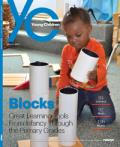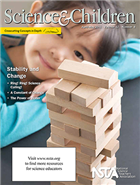Building with Blocks: Exploring stability and change in systems
By Peggy Ashbrook
Posted on 2015-05-10
In my neighborhood, flowing rainwater from rooftops and yards is making a small gully in the hillside before it runs into the street and goes into the storm sewer. The hillside used to be just a grassy slope. As the original bare patch deepened, roots and rocks became visible in the soil. I wondered what changes in the neighborhood made this happen? The neighborhood is a system of surfaces where rain falls and flows off on its way to the river—roof tops, downspouts, drainage pipes to direct the water, trees, grass yards, garden slopes, sidewalks and roads. What changes in this system led to the erosion of the hillside?
Maybe your children can see the changes made by rain or wind in their local environment. Observing these changes can help us think of our neighborhood and environment as a system. “A system is an organized group of related objects or components that form a whole. (NRC 1996).”
 A common and simple system that children work with in early childhood programs is the structure they build from blocks. Teachers have a role in supporting children’s work in block building. Professional organizations that support teaching science, The National Association for the Education of Young Children (NAEYC) and the National Science Teachers Association (NSTA), provide some resources (some at no cost) to help us understand
A common and simple system that children work with in early childhood programs is the structure they build from blocks. Teachers have a role in supporting children’s work in block building. Professional organizations that support teaching science, The National Association for the Education of Young Children (NAEYC) and the National Science Teachers Association (NSTA), provide some resources (some at no cost) to help us understand  how to maximize children’s learning in the block area. The topic of the March issue of Young Children is “Blocks: Great Learning Tools From Infancy Through the Primary Grades.” Two of the articles available to non-members address block building in preschool: Building Bridges to Understanding in a Preschool Classroom: A Morning in the Block Center by Lea Ann Christenson and Jenny James, and Using Blocks to Develop 21st Century Skills by Karen Wise Lindeman and Elizabeth McKendry Anderson.
how to maximize children’s learning in the block area. The topic of the March issue of Young Children is “Blocks: Great Learning Tools From Infancy Through the Primary Grades.” Two of the articles available to non-members address block building in preschool: Building Bridges to Understanding in a Preschool Classroom: A Morning in the Block Center by Lea Ann Christenson and Jenny James, and Using Blocks to Develop 21st Century Skills by Karen Wise Lindeman and Elizabeth McKendry Anderson.
Susan Friedman, Executive Editor of Digital Content at NAEYC, reminisced about the materials on the block shelves in her first classroom on the NAEYC blog—add your comment to describe your block area and how the children use it.
 In the Early Years column in the April/May 2015 Science and Children, I wrote about exploring stability and change in other systems common in early childhood. There are many ways to investigate stability and change in both natural and built worlds. Block building learning in a Head Start classroom is described by Chalufour, Hoisington, Moriarty, Winokur, and Worth in “The Science and Mathematics of Building Structures” in Science and Children (2004).
In the Early Years column in the April/May 2015 Science and Children, I wrote about exploring stability and change in other systems common in early childhood. There are many ways to investigate stability and change in both natural and built worlds. Block building learning in a Head Start classroom is described by Chalufour, Hoisington, Moriarty, Winokur, and Worth in “The Science and Mathematics of Building Structures” in Science and Children (2004).
In block building, children choose the objects or components that form the whole, often making changes as they build to meet their goals of stability, aesthetics and usefulness. “I’m building a road,” a child says, and drives a small model of a car along it. Another child builds a house alongside the road, and then a bridge to go over the road when more children join in building on the other side of the road. Children make changes as they respond to the needs of their imagined community to get across the road. The need to consider balance and stability increases as children build up. Although children control the objects in their built system, they may not yet understand what makes their structure stable.
The Next Generation Science Standards (NGSS Lead States 2013) state that the progression of understanding of the crosscutting concept Stability and Change begins in kindergarten–grade 2 as “students observe some things stay the same while other things change, and things may change slowly or rapidly” (p. 10). An additional goal stated by A Framework for K–12 Science Education is to help children recognize that it can be as important to ask why something does not change as it is to ask why it does (NRC 2012, p. 101).
 Even in second grade, children may be working out how to build a stable tower. In a 1-hour after-school class to explore building ramps to create marble runs, several children in grade 2 tried over and over to support a ramp with a long rectangular block standing on one end. They repeated this process for several weeks although
Even in second grade, children may be working out how to build a stable tower. In a 1-hour after-school class to explore building ramps to create marble runs, several children in grade 2 tried over and over to support a ramp with a long rectangular block standing on one end. They repeated this process for several weeks although  they could see more stable tall structures built by other children and I asked them to think about what they could change to keep their structure from falling over. After more several weeks and pairing with another student, these children are now building stable tall structures. They needed time to construct their understanding through repeated experiences. (More information about building ramp structures can be found on the Regents’ Center for Early Developmental Education’s CEESTEM website at http://www.uni.edu/rampsandpathways/ )
they could see more stable tall structures built by other children and I asked them to think about what they could change to keep their structure from falling over. After more several weeks and pairing with another student, these children are now building stable tall structures. They needed time to construct their understanding through repeated experiences. (More information about building ramp structures can be found on the Regents’ Center for Early Developmental Education’s CEESTEM website at http://www.uni.edu/rampsandpathways/ )
If girls in your program rarely play with blocks, or boys rarely play in the imaginative play center, Janis Strasser and Lisa Mufson Koeppel have some tips for encouraging children to try out the centers they do not usually visit.
In “A Developmental Look at a Rigorous Block Play Program” by Diane Hobenshield Tepylo, Joan Moss, and Carol Stephenson, the authors examine the block play in a prekindergarten class, and encourage us to create a carefully considered block program.
Where do your children investigate stability and change in systems?
Resources
Chalufour, Ingrid and Hoisington, Cindy; Moriarty, Robin; Winokur, Jeff; Worth, Karen. 2004. The Science and Mathematics of Building Structures. Science and Children. 41 (4): 30-34 http://www.nsta.org/publications/article.aspx?id=ZacGSosEPpc=
Lindeman, Karen Wise and Elizabeth McKendry Anderson. 2015. Using Blocks to Develop 21st Century Skills. Young Children 70 (1): 36-43. http://www.naeyc.org/yc/article/using_blocks_develop_21st_century_skills_Lindeman
National Research Council (NRC). 2012. A Framework for K–12 Science Education: Practices, Crosscutting Concepts, and Core Ideas. Washington, DC: National Academies Press. http://www.nap.edu/catalog/13165/a-framework-for-k-12-science-education-practices-crosscutting-concepts
National Research Council (NRC). 1996. National science education standards. Washington, DC: National Academy Press. http://www.nap.edu/catalog/4962/national-science-education-standards
NGSS Lead States. 2013. Next Generation Science Standards: For states, by states. Washington, DC: National Academies Press. http://www.nextgenscience.org/next-generation-science-standards
Strasser, Janis and Lisa Mufson Koeppel. 2010. Block Building and Make Believe for Every Child. Teaching Young Children. 3 (3): 14-15. http://www.naeyc.org/yc/files/yc/file/201503/YC0315_Tepylo.pdf
Tepylo, Diane Hobenshield, and Joan Moss and Carol Stephenson. 2015. A Developmental Look at a Rigorous Block Play Program. Young Children 70 (1): 18-25. http://www.naeyc.org/yc/files/yc/file/201503/YC0315_Tepylo.pdf
Disclaimer: The views expressed in this blog post are those of the author(s) and do not necessarily reflect the official position of the National Science Teaching Association (NSTA).


